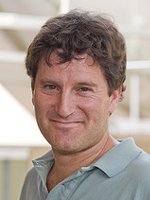|
Distinguished
Lecture Series 2011 - 2012
|
|
|
|
Michael Brenner
Harvard University
Glover Professor of Applied Mathematics and Applied Physics
Faculty Associate, Harvard University Center for the Environment
Participant, Materials Research Science and Engineering Center
|
|
Lecture 1: Singularities and Droplet Splashing
(Joint talk with UCLA Mechanical and Aerospace Engineering)
I will discuss our recent efforts to develop a first principles, theoretical description of the events leading to droplet splashing on a solid surface, by focusing on a peculiar singularity that occurs in the equation of motion before the droplet contacts the substrate. Experiments have long showed that the most violent splashes are preceded by the ejection of a very thin fluid sheet from the vicinity of the contact point, though the fluid mechanical origin of this sheet has been completely unclear. From simulations and a theoretical discussion beginning from the Navier Stokes equation, we demonstrate that the sheet originates before the droplet contacts the solid surface, and give detailed predictions for the characteristics of the sheet (thickness, speed, velocity). For a ~ 1mm droplet thrown at a surface at a few meters per second, the sheet ejects upwards at 100m/sec when the droplet is 10s of nanometers from the solid surface. Recent experiments probing these predictions will also be described.
Lecture 2: Science and Cooking: Special Public Lecture Co-hosts: IPAM & CNSI
(Joint talk with Professor Amy Rowat, UCLA Department of Integrative Biology and Physiology)
Much of cooking, both that which you practice every day, and that which is practiced by the world's finest chefs, is strongly rooted in science and scientific principles. With a little bit of knowledge about some basic principles in science, as well as methods for making measurements, experiments in the kitchen can be reinterpreted in scientific terms, leading to new culinary creations. We will describe the development of a science course at Harvard (debuted in the Fall of 2010) on this topic, in which we used cooking as the basis to teach science to 300 non-science undergraduates. Each week we were visited by a world famous chef (e.g. Ferran Adria, Jose Andres, Grant Achatz, Bill Yosses, Dan Barber, Wylie Dufresne...), who illustrated the scientific principles of the week. Each lesson was illustrated by a laboratory, in which the students carried out and made scientific measurements on a recipe--understood in quantitative terms by an equation. This lecture will summarize the intersection of science and cooking, focusing on its use as a pedagogical device for teaching science.
Video
The lecture is now available online.
View here
Lecture 3: Linear Algebra and the shape of bird beaks
Evolution by natural selection has resulted in a remarkable diversity of organism morphologies. But is it possible for developmental processes to create "any possible shape"? Or are there intrinsic constraints? I will discuss our recent exploration into the shape of bird beaks. Initially, inspired by the discovery of genes controlling the shapes of beaks of Darwin's finches, we showed (joint with O. Campas, R. Mallarino, A. Herrell and A. Abzhanov) that the morphological diversity in the beaks of Darwin's Finches is quantitatively accounted for by the mathematical group of affine transformations. We have extended this to show that the space of shapes of bird beaks is not large, and that a large phylogeny (including finches, cardinals, sparrows, etc) are accurately spanned by only three independent parameters. After summarizing the evidence for these conclusions, I will delve into efforts to create mathematical models that explicitly connect these patterns to developmental mechanisms, attempting to answer what are the essential changes that cause such wide diversity in the shapes of bird beaks.
Lecture 4: Sphere packings and self assembly
Self assembly is the idea of creating a system whose component parts spontaneously assemble into a structure of interest. In this talk I will outline our research program aimed at creating self-assembled structures out of very small spheres that bind to each other on sticking. The talk will focus on (i) some fundamental mathematical questions in finite sphere packings (e.g. how do the number of rigid packings grow with N, the number of spheres); (ii) algorithms for self assembly (e.g. suppose the spheres are not identical, so that every sphere does not stick to every other; how to design the system to promote particular structures); (iii) physical questions (e.g. what is the probability that a given packing with N particles forms for a system of colloidal nanospheres); (iv) comparisons with experiments on colloidal nanospheres.
|
|
Lectures
- Lecture 1: October 25, 2011 - Tuesday @ 12:00 -
12:50 pm in Engineering IV, Room 38-138
- Lecture 2: October 25, 2011 - Tuesday @ 4:00
- 4:50 pm in CNSI Auditorium
- Lecture 3: October 26, 2011 - Wednesday @ 4:00
- 4:50 pm in MS 6229
- Lecture 4: October 27, 2011 - Thursday @ 3:00
- 3:50 pm in MS 6627
|
|
|
|
|

